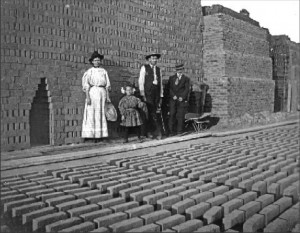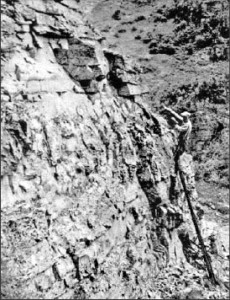by George Sibley
October 16-18 Western State College will hold its 20th Headwaters Conference in Gunnison – 20 years of open discussion on who and what we are, here in the mountains of central Colorado. It’s a good time to try to revisit the roots of the idea – and to look how it has branched out.
The Headwaters idea at Western was triggered by a book. In fact, a big doorstop book called “The Last Best Place: A Montana Anthology,” a thousand-page collection of 150 years of writings about Montana published in 1988. Bill Hamilton, then President of Western, flagged me down one day when I was walking by his office, and showed me the book: “Why doesn’t Colorado have something like this?” he asked.
Actually, Colorado had several anthologies by then, although none on quite that scale. But his interest watered an idea that was already sprouting in my mind. I was in my second term on a one-year temporary contract as a part-time instructor at Western – basically cheap labor to work in a new interdisciplinary program that none of the tenured faculty wanted to teach.
That interdisciplinary program was part of a re-designed role for Western State in the state’s higher education system, a consequence, first, of the nationwide crash of enrollments in higher education as the “baby boom bulge” ended in the early 1980s. Second, substantial criticism of American higher education exemplified by a Carnegie Foundation “blue ribbon” report on undergraduate education – too fragmented, too abstract, too unrelated to the realities of the world students will become part of. Colorado had responded to the first problem by downsizing and refocusing the missions of all of the state’s public colleges and universities, and to the second problem by charging Western to become an “exemplary undergraduate institution” (whatever that meant).
So the college had half-heartedly drafted up an interdisciplinary “core” program, and brought in the academic equivalent of immigrant labor (adjunct faculty) to teach it. Myself, I thought it was great, and that it should go farther. It seemed totally logical to me that the best way to integrate the many facets of a liberal arts education was around “place” – because every place is truly comprehensible only through a balanced understanding of the natural sciences, the social sciences, the arts and humanities. And where better to try to integrate education around “place” than at a college where most of the students (and faculty) came not for the college itself so much as for the incredible place where the college was?
So anyway – the morning after he’d raised that question about the Montana book, I gave the president a two-page draft of an idea for a process – an annual place-oriented conference – that would eventually lead to an authentic product – an anthology about the place. Only, I said, it should not be about the geographic irrelevance called Colorado. It should be about the college’s region. We should take note of the fact that we were the four-year college closest to the headwaters of all of the major rivers so important to the Southwest, and we should use this location to brand ourselves as “the Headwaters College of the American Southwest.”
In a practical sense, I was just trying to extend my one-year temporary contract to at least another year by inventing more “academic odd jobs” no one else would want to do. But I also believed that it was truly a good idea that could help the college. And how could a college president saddled with the Carnegie Report, and a revised mission from a legislature that had seriously entertained an alternative proposal to turn Western into a medium-security prison – how could he not bite on such a hook?
So six months later, in October 1990, Western hosted its first “Headwaters Conference.” It didn’t hurt that the president was on the board of the Colorado Endowment for the Humanities, which gave us some money to advance the idea and the college found some matching funds. Also, we were able to bring in some pretty good names – historians Patricia Limerick and Laura McCall, humanist and Jefferson impersonator Clay Jenkinson, novelist John Nichols, poet Art Goodtimes, High Country News publisher Ed Marston, Hispanic anthropologist Devon Pena, Greg Cajete of the American Indian Institute in Santa Fe – to address various aspects of “The Reopening of the American Frontier” (“closed” 100 years earlier by Frederick Jackson Turner). Nothing much was resolved, but we all had a great time and went home with full brains.
In truth, nothing much was ever resolved in the 18 conferences I organized over the following two decades. It is not really the function of conferences to resolve anything. The idea is just to get a lot of ideas, feelings, philosophies out on the table and into people’s minds and hearts, new thinking to take home for a new look at old issues. We wanted people to go home “expanded” – a little confused, a little inspired, with lots of new things running around the labyrinths of their minds, and Headwaters has fairly consistently fulfilled that function. A woman who comes down from Steamboat Springs every year calls it her “think tank.” The conference never became huge in terms of attendance, but it gathered an interesting group of “regulars” from around the region – “elders,” we started to call ourselves, and most of us have in fact become elderly over those two decades, which is a little problematic, and one reason I decided it was time to step aside and let some interested younger faculty take it on.
Has it made any difference? It has for the college, which has ceased to be embarrassed by the fact that its students come here for the place as much as the education, and has made the place an increasingly important part of the education. The book, “The Headwaters Reader,” remains what old Governor Gilpin would call “an untransacted destiny.” It might still happen though. And there were additions to the college curriculum – briefly, a “Headwaters Regional Studies Minor” that no one at Western really understood. But the larger idea of integrating education around place has been folded into the mix of a new and very interdisciplinary Environmental Studies program, along with a short course I had invented as an introduction to the region.
The “Headwaters Project” has also had effects around the region. Ed Quillen, founder of this magazine, came to part of that first conference, and thereafter became a regular attendee and frequent speaker and responder. In 1994 he and his partner Martha started Colorado Central Magazine, and Ed said at one conference that if he were filing a patrimony suit, he would name Headwaters: “I realized I was living in an interesting and creative region, with some good writers, and the magazine seemed like a good idea.”
Art Goodtimes from the San Juans – an unapologetic 60s hippie poet when the conference began, but now a three-term San Miguel County Commissioner and a growing political force in Western Colorado (and still an unapologetic 60s hippie poet who has still not trimmed his beard) – credits the conference for helping to refine and rethink his former hard-line environmentalism; he has now become one of the West’s leaders in the challenge of finding the common grounds that enable cultural and environmental problems to be resolved. While it has not always been so dramatic as that, other regional leaders have taken home new perspectives that show up over the years.
The “Headwaters Project” also led to the naming of a minor peak in the Cochetopa Hills. A little 11,862 foot hill on the Continental Divide, about 4 miles south from Marshall Pass, turns out to be one of only five “triple divides” in North America, where three major river basins have a common point of origin. Tributaries of the Rio Grande and the Arkansas and Colorado Rivers all flow from that modest hump on separate journeys to the Atlantic and Pacific. Some Headwaters students, aided by a cartographer from Denver and articles by Ed Quillen both in this magazine and the Denver Post, persuaded the U.S. Board of Geographic Names to officially adopt the name “Headwaters Hill,” which is now showing up on new maps.
But the Headwaters conference remains the heart of the project. This year’s topic is “Redefining Prosperity: Transitioning to the Triple Bottom Line,” an exploration of how we can keep life interesting when we actually have to live responsibly on earth. The conference has been moved from its usual early November date to accommodate the schedule of the renowned Vandana Shiva, a physicist, author, and activist from India, and recipient of a “Right Livelihood Award” (the “alternative Nobel”), who will speak to the conference on Oct. 17. The other principal speaker (Oct. 16) will be Dr. Devon Pena, anthropologist, author, and founder of the Acequia Institute to protect and nurture the water-use culture of southern Colorado and northern New Mexico – the southern reach of the Headwaters Region.
The full schedule, along with other Headwaters information, can be found at www.western.edu/headwaters. It is always a good time with good people.
George Sibley was born is Western Pennsylvania, but was conceived in Colorado, by Colorado natives, and thus considers himself to be a native Coloradan.

